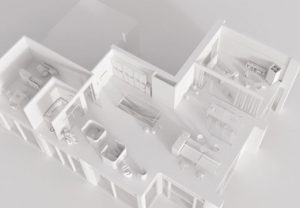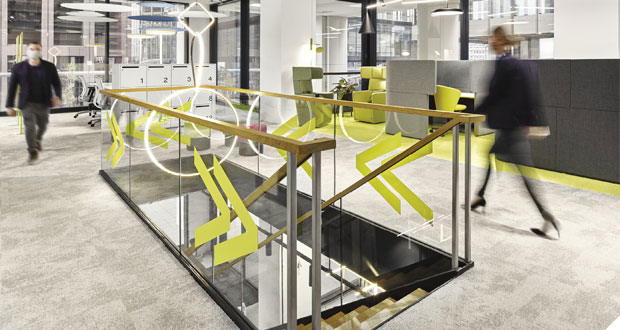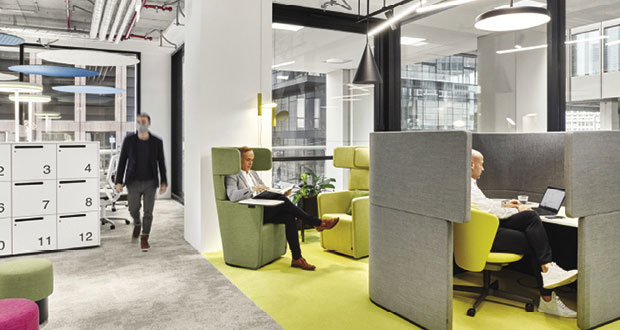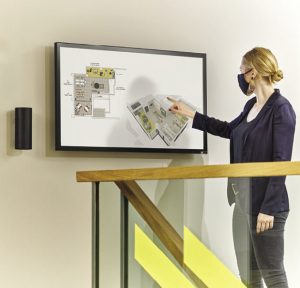Spatial awareness: The focus of the entire office space is on teamwork and exchange, all the while maintaining the correct distance. The room configurations are designed in such a way that they can be adapted to changing needs at short notice at any time, including screens that can be made with mobile partitions and partition elements.
“The spatial concept is open and flexibly designed,” says Möckesch. “Anchor points, in the form of furniture, are clearly placed in collaboration areas to ensure appropriate distancing. The room configurations are designed in such a way that they can be adapted to changing needs at short notice, giving the office breathing space. In addition, moveable partition walls and shielding elements can be used as protective barriers.”
A new kind of exchange and interaction: The space offers a wide choice of spaces for project and teamwork, in addition to the team workspace and an informal meeting area. Other areas enable spontaneous stand-up meetings, ensuring an optimal exchange of ideas.
Says Möckesch: “The office is a living organism that is constantly evolving and adapting to changing structures and the latest processes in a company or team. It is important to think about these plans and space concepts on a regular basis and make sure they are still serving their purpose.”
The pandemic has resulted in many enclosed meeting rooms being repurposed as additional spaces to enable social distancing, so does this mean that meeting spaces will be more fluid in the future for more flexible and less formal engagements?
Möckesch certaintly thinks so: “Because aspects like collaboration and interaction will gain greater importance in the post-pandemic world of work, meeting and communication zones are becoming increasingly important in the office. The office must offer space for teamwork, ideas and opportunities, and become a motor for innovation. It is about the right mix of formal and informal zones. Today, in addition to the traditional meeting room, there must also be project spaces, video conference rooms, workshop areas and the possibility for quick, spontaneous exchange.”
No-one knows exactly how or when the pandemic will end but there is no doubt that it has altered the office landscape immeasurably. The idea behind THE CORE is that you can constantly learn. The sensor technology throughout enables the collation and analysis of data to determine which spatial settings are particularly popular. Revisions and improvements can be continually made to create the most efficient and effective workplaces.
Explains Michael Fried: “Modern office concepts are characterised by more communal areas that can be used flexibly and can be easily adapted to a wide range of requirements. The importance of the office as a hub for information, corporate culture and social interaction is growing. Offices must convey a sense of security, orientation and trust in order to continue to be inspiring places for people to meet and be creative in the future.”
POST-PANDEMIC PREDICTIONS
Some of the questions that arise from the impact of the pandemic are also addressed in this experimental setting, including whether the agile office is still feasible – given the need to constantly clean/disinfect work areas.
According to Möckesch: “Flexible room concepts make more sense than ever. You have just to use the right tools, such as sensor technology, to ensure that hygiene concepts are adhered to and the risk of infection is minimised.”
It’s also being widely predicted that remote working and the hybrid/home and office work pattern will remain prevalent after the pandemic. This predicts Möckesch will influence the interior design of the workplace.
“Working from home will remain relevant as an integral part of the office landscape, as it has become a very effective option for concentration and focused work. The design of office space is changing, with areas for communication and collaboration moving into focus. Therefore, it is necessary to realise high design quality at the office, to help to encourage staff to work from there.”
The other key question is how the office can support new ways of working and how the use of digital technology can help encourage people to engage with the culture of the workplace, wherever they’re based?
Says Möckesch: “The office is in direct competition to the home office. It is important to develop holistic concepts to create psychological wellbeing in addition to physical wellbeing. More than just ergonomics, holistic design and sensory technology will be an essential part of the user experience, creating a vivid office landscape with various areas that offers the right space for the individual task and process. The office is the place where you meet your  colleagues, where face-to-face exchange is possible. It is a place of exchange with others, where inspiration and new ideas can take place. Spatial opportunities for exchange – informal as well as formal – must be available.”
colleagues, where face-to-face exchange is possible. It is a place of exchange with others, where inspiration and new ideas can take place. Spatial opportunities for exchange – informal as well as formal – must be available.”
Because the world of work and the office environment are already in a state of flux, through the analysis of the data it provides, THE CORE will not lose its relevance, even after the pandemic is over.
FURTHER INFORMATION
https://bene.com/de/the-core-by-bene/







